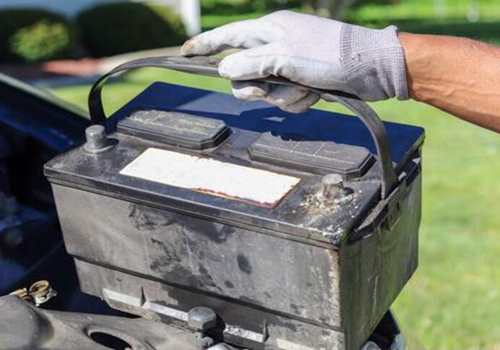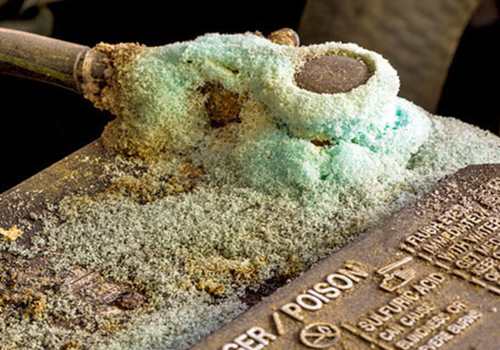
Corrosion is quite a normal problem when it comes to battery terminals. It usually happens due to the release of Hydrogen gas which reacts with the components near the battery of the car. It might also happen because of electrolyte leakage. If only one of the terminals has corroded, the reason can be slightly different. When only a negative terminal goes under corrosion, it is usually due to undercharging of the battery. However, if you are wondering what causes car battery corrosion on the positive terminal? It is majorly due to overcharging.
What is Required for Cleaning?
- WD-40
- Wrench
- Screwdriver
- Toothbrush
- Safety glasses and gloves
- Cloth
- Dielectric grease or petroleum jelly
Procedure
Before you begin the cleaning, the process makes sure your car ignition is turned off and you have all the necessary tools and equipment with you. Here are a few simple and easy steps that you can use for cleaning your car battery terminals with Wd40:
- Safety is important. Wear gloves and safety glasses for protection.
- Use a wrench to loosen the nuts of the terminals.
- Now you need to remove the terminals. Remove the negative one first. If you find it hard to take them out, use a screwdriver to push them upwards. It loosens them up to a great extent. However, be careful of the short circuit that can be caused in the battery terminals because of the screwdriver.
- Spray Wd40 on each terminal and use the toothbrush to scrub off all the deposits and use a clean piece of cloth to wipe it off.
- Reattach the terminals and make sure to go for the positive one, first this time.
- Once the whole cleaning process is completed. Use the dielectric grease to coat the terminals. This will prevent corrosion in the future.
I always come across questions like why does blue powder appears on a negative battery terminal? The battery terminals are made of copper and the electrolyte in the battery is diluted sulfuric acid. Even if the slightest amount of electrolyte touches the terminal (mistakenly), the diluted Sulphur acid begins to react with the copper. This results in the formation of anhydrous copper sulfate. An anhydrous compound is formed because of the diluted form of the electrolyte i.e. Sulphur acid. This compound is that blue deposit that usually appears on the terminals.
Cu + 2*H2So4 = CuSo4 + 2*H2o+ So2
Uses of WD40 on Cars
WD40 serves more than one purpose. It is not just a cleaner but also a lubricant. It can be used for following things:
- Easily Loosen and Tighten Wheel Nuts
Not only it is a cleaner but WD40 can also be used as a lubricant. A single spray-on wheel nuts can grease them up for you to tighten or loosen them with minimum effort.
- Clean and Shine Engine Bay
It makes a huge difference for your engine bay. Spray a little WD40 on it and give it a nice rub with a piece of clean cloth; it will not only clean it thoroughly but also make it shinier.
- Restore Unclear Headlights
Spray WD40 on the fogged headlights and wipes it off with a clean microfiber cloth. They’ll be good as new.
- Clean and Shine Tire Sidewalls
The sidewall of tires tends to get all dusty and accumulate tough dirt. Cleaning them with soap water and brush takes more effort and the result is not even half as good as WD40’s. It makes them shinier and improves tires’ life too.
- Remove and Fix Body Scratches
When using it for scratches, make sure to use a small amount of it. The wiping is what makes the difference. Thoroughly and gently wipe it all over the scratched area to get rid of any scratches.
- Fix Annoying Door Squeaks
As a lubricant, I often use it to fix squeaky doors of my truck. Spray a very little amount of WD40 in the hinge, and your annoying squeaky door is fixed. Make sure to not go generous on the spraying as lubricants tend to trap dust and it might create a problem.
- Clean and Shine Rims
A car looks attractive with shiny rims, to maintain that look, clean them with Wd40. Just a couple of spritz and wipe it all around the rims. They remain shiny, clean, and protected from dust and dirt collection.
- Corrosion-free Car Battery Terminal
If you have corrosion on the battery terminals, WD40 can help you to get rid of corrosion with its multipurpose nature and safe formula which will prevent the accumulation of the terminals.
- Improve Spark-Plugs Connectivity
Spraying WD40 on spark plugs with a good amount will make sure to improve its connectivity which affects the functionality, all in all.
What Causes Corrosion on Car Battery Terminals?

I frequently get asked about the deposits on the car battery terminals and their causes. The deposit occurs due to corrosion and here a few reasons why corrosion occurs:
- Loose Terminals
Loose terminals often lead to undercharged batteries which can be the reason behind the wear and tear.
- Overfilling
The electrolyte in the battery must not be overfilled as even the slightest contact with terminals can lead to corrosion.
- Overcharging
It can corrode the positive terminal quite fast.
- Undercharging
Negative terminal damage is caused by undercharging the battery.
- Hydrogen gas
Hydrogen gas emission from the battery can come in contact with the terminals and leads to corrosion.
What is the Best Thing to Put on Battery Terminals?
Every part of the car requires maintenance and attention but car battery terminals in specific require attention as corrosion is most likely to occur there. I always recommend people to keep their car battery terminals clean and use silicone dielectric grease to prevent the terminals from all kinds of wear and tear in the future. It is far more effective than any other dielectric grease or petroleum jelly.
The reason I prefer and recommend silicon dielectric is that its melting point is quite high which means regardless of how hot it gets, the silicon would not melt. With a rise in temperature, silicone begins to vulcanize. In simpler words, it gets only better as it turns even harder (solid) providing more protection. These attributes are missing in petroleum jelly or other types of dielectrics.
How to Put Dielectric Grease on Battery Terminals?
Using dielectric to protect your car battery terminals is a wise choice. I always make sure to apply one right after cleaning them. The right way of applying a dielectric is to:
- Clean the terminal thoroughly before applying it. Use the above-mentioned method for cleaning.
- Coat each terminal with the dielectric grease evenly. Make sure to cover it all.
- Reconnect each terminal; go for positive one first and then negative terminal.
Is it OK to use Vaseline on Battery Terminals?
This question is probably the most asked one as finding a good dielectric grease that is budget-friendly at the same time, can be a little tricky at times if you are in a remote area. Yes! You can use Vaseline for protecting your car battery terminals. However, it is just a temporary solution as it is not that reliable. When the temperature increase, Vaseline, which is a petroleum-based jelly, melts. It results in the penetration of melted grease between connections reducing the voltage. Its better to use in the winter season.
What to Put on Battery Terminals to Prevent Corrosion?
The market has various options you can use when it comes to extra protection for your car battery terminal. This will prevent corrosion in the future. They are not that expensive and you can easily find them online. Here are the most recommended options you can purchase to prevent corroding terminals:
Permatex 22058 Dielectric Tune-Up Grease
This dielectric grease is perfect for keeping your car battery terminal dirt, salt, and corrosion-free. This grease has a lot to offer; you can use it on spark plug boots, marine and automotive electrical connections, trailer hitches. Click Here to Watch Latest Price and Details.
Vaseline Pure Petroleum Jelly, Original
Petroleum jelly is a thick hydrocarbon-based compound which is great for protecting the car battery terminal. However, it is recommended to use it in winter as it does not last that long and melts pretty quickly. This is an easier and cheaper way of protecting the terminals. As it comes in a pack of two so it will go a long way. Click Here to Watch Latest Price and Details.
NOCO NCP2 MC303S Battery Protector Pads
It provides high-end protection to your car battery terminal and increases their life. Even after becoming saturated with deposits, the gel does not dry out. This oil-based formula is USA-made which speaks for its reliability, itself. It will prevent all kinds of corrosion and leakage to keep your battery’s health optimal. Click Here to Watch Latest Price and Details.
How to Clean Battery Connectors?
Cleaning battery connectors is important as deposition on the connector can make a difference in the voltage which does not only cause problems for the vehicle but also reduces battery life. There are different ways used for cleaning the battery connectors.
- Remove the terminals and clean them with terminal cleaner. You can find one in any auto parts shop nearby.
- For the rust check, spray the whole thing including the terminals, and post with the cleaner spray.
- Reattach the terminals and tighten to secure them in their place.
- Use a good quality dielectric grease or simple Vaseline to coat the terminals to keep them safe from corrosion. It prevents them from moistures and vapors.
The best thing about this process is that you need to do it only once for a battery and annually retouch the dielectric. In this way, you will have zero build-up problems, no corrosion, and your car battery life would also extend.
Which is the Best Car Battery Corrosion Cleaner?
The market is quite saturated which makes shopping of auto parts quite hectic. Looking for a good car battery corrosion cleaner can be difficult at times as most of the time people do not exactly know what to look for. A good cleaner has power to remove corrosion, debris, dust, oil, it also provides protection against rust. You will find all the properties of a good cleaner in WD-40 Specialist Electrical Contact Cleaner Spray as it is one of the best car battery corrosion cleaners.
It is an electric cleaner that helps in removing all kinds of build-ups including dirt, oil, condensed vapors, and flux residue. Its quick-dry formula makes it suitable for all types of material. The best feature of this spray is its industrial strength and high penetration that offers a targeted solution for a very specific problem. It is ideal for blasting build-up from printed circuit boards, switches, electric panels, and precision instruments. The design of the spray is built in a way that will provide high precision for reaching even the most sensitive parts.
What Does WD40 stands for?
WD40 stands for Water Displacement 40. It is named after the scientist who invented this beneficial chemical back in 1953. Norm Larsen was a scientist based in San Diego, California whose major aim was to invent a chemical that will prevent metal from corroding. All his attempts failed to util the 40th time when he finally succeeded in creating the perfect formula. This is what led to the name WD-40. Its popularity began to increase in 1958 when it made its way to the shelves; by 1993, around 1 million of these cans were sold. Now, WD40 has become highly popular, and it is available in almost 185 countries around the world.
